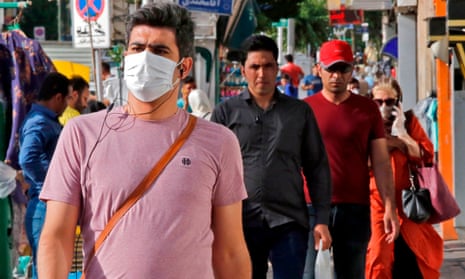Iran is reluctantly confronting the possibility of a renewed political crisis as well as a health one after the latest figures showed the number of new coronavirus infections at a record high.
The government appeared to have brought the virus under control a month ago, but a second wave of the virus has steadily been gathering pace. According to data released by the health ministry on Thursday there were 3,574 confirmed new infections in 24 hours – an increase of 440 on the previous day.
The previous daily record in Iran was 3,186 on 30 March. The country was one of the first in the Middle East to be gripped by the disease.
In spite of a steadily rising infection rate, authorities have been progressively lifting controls on shops, mosques, schools, offices and travel. The border with Turkey was also being opened for haulage traffic on Thursday.
In recent days government spokesmen have been increasingly critical of the public, accusing them of ignoring the continued restrictions, especially in workplaces.
Hassan Rouhani, the country’s president, said: “If the rules are not obeyed the government would be forced to restore the quarantine situation again, disrupting normal life and inflicting serious damage on the entire national economy.”
There was little immediate domestic coverage of the record infection figure.
The chief solace for the health ministry was that the number of daily deaths has not risen at the same rate as new infections, giving some credence to the argument that the increased level of infections is partly a result of more widespread testing and better recording. The number of deaths recorded in the previous 24 hours was 59, taking the death toll to 8,071. The highest number of daily deaths was 158 on 4 April.
Officials now face a dilemma over whether to reimpose controls, a move that will be unpopular and damage the sanction-weakened economy, or hope that the second wave will somehow peter out. Only 10 days ago the number of new infections was below 2,000, and the rapid rise in the last five days cannot be explained solely by widespread testing.
The virus was reported as being worst in the provinces of Khuzestan, Hormozgan, Kurdistan and Kermanshah. All people in those regions were advised to wear face masks in public.
Anecdotal evidence from Hormozgan suggested women were contracting the disease while shopping. Nearly 25% of those with the disease were classified as “housewives”.
In a sign of the competing pressures facing the government, the Iranian parliament research centre produced figures to show per capita income in the country had fallen by 34% over the last three years, partly because of inflation. Nearly 60% of employees were not covered by social insurance.
In other coronavirus developments around the world:
Spain wants to welcome back British tourists from 1 July, but said that would depend on the UK’s 14-day quarantine plan for arrivals, including returning UK citizens, and on the British authorities rescinding advice on non-essential foreign travel.
France said it would cancel its traditional 14 July Bastille Day military parade and replace it with a ceremony to pay tribute to care workers.
Russia’s relatively low official death toll was further brought into question after St Petersburg issued 32% more death certificates in May than in the same month last year.
The number of confirmed cases in Afghanistan passed 18,000, with more than 300 deaths, amid a continued surge of transmissions in Kabul.
Pakistan reported a record single-day high in coronavirus deaths (82) and new cases (4,688), saying it was due to increased testing.
The World Health Organization’s director for Africa said the continent’s 162,622 confirmed coronavirus cases and 4,604 deaths was “broadly accurate”, but the African Union health agency said the continent needs to triple its testing.
A further 1.9 million people filed for unemployment benefits in the US last week, bringing the total number of claims to more than 42m since the pandemic hit.
In Japan, Tokyo’s governor said it may be necessary to stage a “simplified” Olympics next year owing to the impact of the pandemic.
China said foreign airlines blocked from operating in the country could resume limited flights, a day after Washington suspended all Chinese travel into and out of the US.
In Latin America, Mexico announced more than 1,000 deaths in a day for the first time and Brazil, the region’s worst-hit country, reported a record 1,349.
